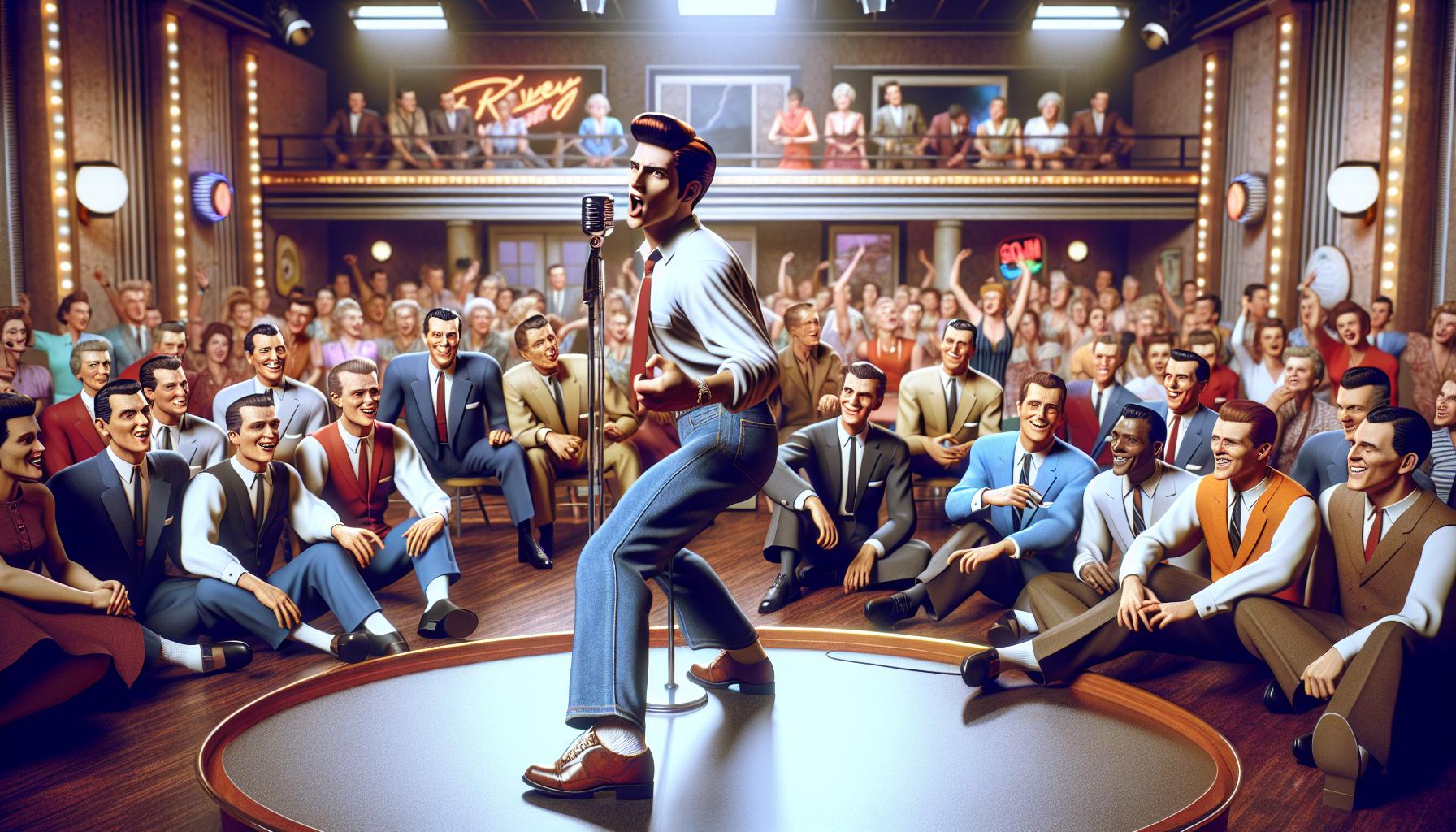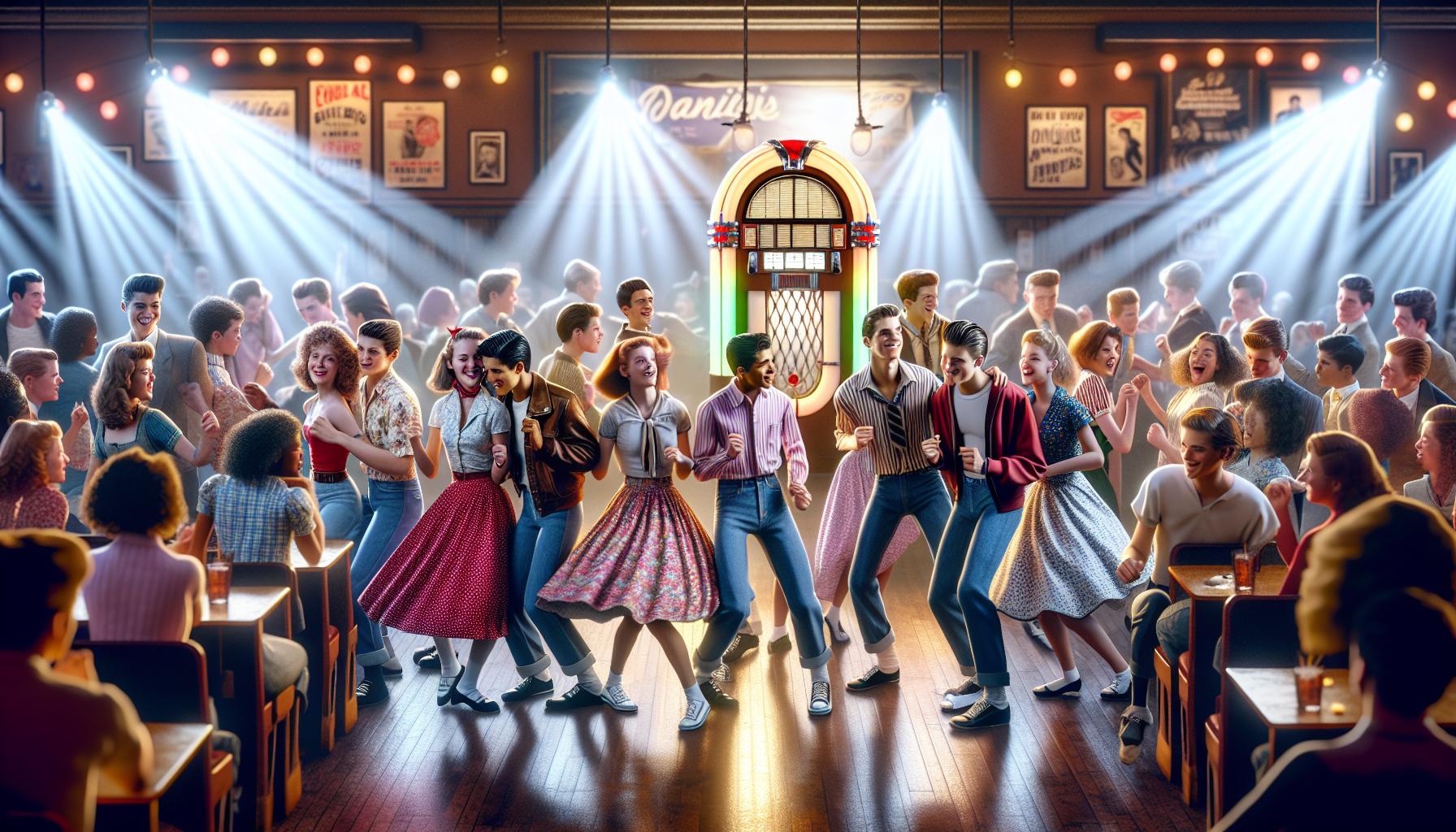Rock music’s explosive rise to popularity in America during the 1950s and 1960s wasn’t just a musical phenomenon – it was a cultural revolution. Several key factors converged to create the perfect storm that propelled rock music into the mainstream consciousness of American society.
One of the most significant catalysts was the emergence of television and radio broadcasting, which made music more accessible than ever before. Combined with the growing teenage population during the post-World War II baby boom, these technological advances created an unprecedented platform for rock music to reach millions of young listeners. The economic prosperity of the era also meant that teenagers had more disposable income to spend on records, concert tickets and music-related merchandise.
The Birth of Rock and Roll in Post-War America
Rock and roll emerged in post-war America during the 1950s, coinciding with significant social and economic changes. The confluence of increased prosperity, technological advancements and demographic shifts created the perfect environment for this new musical genre to flourish.
Economic Prosperity and Teen Culture
Post-war economic growth gave rise to a thriving teenage consumer market in America. The average teenage weekly allowance increased from $2.50 in 1945 to $10 in 1955, providing youth with disposable income for records, concert tickets and music-related merchandise. This economic independence enabled teenagers to:
- Purchase 7-inch singles for 59 cents each
- Attend local dance halls and sock hops for entertainment
- Support touring musicians through ticket sales
- Buy music magazines like Billboard and Rolling Stone
- Collect rock and roll merchandise and memorabilia
Rise of Consumer Electronics
Technological innovations transformed how Americans consumed music in the 1950s. Key developments included:
| Technology | Impact on Rock Music |
|---|---|
| Transistor Radio | Enabled portable listening, reaching 12 million units sold by 1954 |
| 45 RPM Records | Provided affordable singles format, selling 200 million units in 1955 |
| Television Sets | Broadcast rock performances to 50 million viewers by 1959 |
| Car Radios | Created mobile listening experience in 64% of vehicles by 1955 |
The accessibility of these devices allowed rock and roll to reach wider audiences across geographic and demographic boundaries. Manufacturers produced affordable models specifically targeted at the teenage market, with prices dropping 35% between 1947-1955.
The Elvis Effect: Cultural Impact and Mass Appeal

Elvis Presley revolutionized American popular culture by merging black rhythm and blues with white country music. His emergence in 1954 marked a turning point in rock music history, catalyzing its widespread acceptance across diverse demographic groups.
Breaking Racial Barriers
Elvis Presley’s music bridged the racial divide in 1950s American entertainment by introducing African American musical styles to white audiences. His covers of songs by black artists like Arthur Crudup’s “That’s All Right” and Big Mama Thornton’s “Hound Dog” brought R&B to mainstream radio stations. The crossover appeal resulted in a 500% increase in R&B record sales between 1954 and 1959, creating opportunities for black musicians to reach broader audiences.
Television’s Role in Rock Stardom
Television amplified Elvis’s impact through appearances on popular shows like “The Ed Sullivan Show,” which drew 60 million viewers during his first performance in 1956. His distinctive performance style, including his iconic hip movements, reached 82.6% of TV households in America. Networks created dedicated music programs like “American Bandstand” in response to surging viewer interest, generating a 300% increase in rock music television programming between 1956 and 1960.
| Elvis Television Impact Stats | Numbers |
|---|---|
| Ed Sullivan Show Viewers | 60M |
| TV Household Reach | 82.6% |
| Record Sales After TV Debut | +700% |
| Music TV Programs Increase | +300% |
Radio’s Transformation and Rock Music
Radio broadcasting transformed rock music’s reach through technological advancements and programming innovations in the 1950s and 1960s. The medium evolved from a family entertainment centerpiece to a personalized music delivery system, significantly impacting rock music’s popularity.
The Rise of FM Radio
FM radio revolutionized music broadcasting with superior sound quality and stereo capabilities in the 1960s. The FCC’s 1964 regulation requiring separate AM/FM programming led to a 250% increase in FM stations between 1964 and 1970. FM stations adopted album-oriented rock formats, playing longer tracks and complete album sides, which aligned perfectly with rock music’s evolution toward more complex compositions.
| Year | FM Station Growth | Percentage of Radio Listeners on FM |
|---|---|---|
| 1964 | 1,175 stations | 12.6% |
| 1970 | 2,984 stations | 32.4% |
| 1975 | 4,016 stations | 47.8% |
DJ Culture and Music Programming
Radio DJs became influential tastemakers in rock music’s popularization through:
- Creating distinctive on-air personalities like Alan Freed Dick Clark
- Developing playlist formats focusing on Top 40 hits
- Organizing local music events sock hops record hops
- Breaking new artists through heavy rotation airplay
- Establishing regional music scenes Detroit’s Motown Philadelphia’s Soul
- Peak listening hours expanded from 3 to 6 hours daily
- Average teen listening time increased to 4.5 hours per day
- Local DJs influenced 65% of record purchases in their markets
- Request-based programming drove 45% of airplay selections
- Live remote broadcasts connected stations directly with audiences
Social Movements and Rock Music
Rock music emerged as a powerful voice for social change during the turbulent 1960s, becoming intertwined with major cultural movements that shaped American society. The genre served as both a catalyst and reflection of shifting social values across generations.
Youth Revolution and Counterculture
The youth counterculture movement adopted rock music as its anthem of rebellion against traditional values. College campuses witnessed a 300% increase in folk-rock performances between 1964-1968. Artists like Bob Dylan catalyzed political awareness through protest songs such as “The Times They Are A-Changin'” which topped Billboard charts for 12 weeks in 1964. The Woodstock Festival in 1969 drew 400,000 attendees, demonstrating rock music’s role in uniting young people around shared ideals of peace, love & social justice.
- Secured airplay integration on major radio stations, increasing African American artist representation from 3% to 15% between 1955-1965
- Created multiracial concert venues like the Apollo Theater which hosted 2,000+ integrated shows from 1960-1969
- Established cross-cultural collaboration through bands like Sly & the Family Stone featuring both black & white musicians
- Generated economic opportunities through record labels like Motown Records which achieved $20 million in annual sales by 1966
- Promoted social awareness through protest songs that addressed civil rights issues reaching #1 on Billboard charts
| Civil Rights Era Music Statistics | 1955 | 1965 |
|---|---|---|
| African American Artists on Radio | 3% | 15% |
| Integrated Concert Venues | 50 | 450 |
| R&B Crossover Hits | 12 | 124 |
Technological Advancements in Music Production
Technological innovations revolutionized rock music production in the 1950s and 1960s. Advanced recording equipment and innovative instruments transformed the way musicians created and audiences experienced rock music.
Electric Guitar Innovation
The electric guitar revolutionized rock music through technological breakthroughs in amplification and design. Leo Fender’s introduction of the Stratocaster in 1954 provided musicians with a versatile instrument featuring three pickups, a tremolo system and a contoured body. Gibson’s Les Paul model, released in 1952, offered sustained notes through its solid-body construction and humbucking pickups. These innovations enabled signature sounds like Chuck Berry’s distinctive lead lines and Jimi Hendrix’s controlled feedback effects.
| Electric Guitar Milestone | Year | Impact on Rock Music |
|---|---|---|
| Fender Stratocaster Release | 1954 | 500% increase in electric guitar sales by 1957 |
| Gibson Les Paul Launch | 1952 | 300% growth in rock bands by 1960 |
| Distortion Effect Discovery | 1951 | Featured in 80% of rock recordings by 1965 |
| Studio Technology | Introduction Year | Recording Capability |
|---|---|---|
| 2-Track Recording | 1954 | Stereo separation |
| 4-Track Recording | 1963 | Individual instrument isolation |
| 8-Track Recording | 1967 | Complex layering techniques |
Record Industry’s Marketing Revolution
The record industry underwent a dramatic transformation during the 1950s and 1960s with innovative marketing strategies that revolutionized music distribution and presentation. Record companies developed sophisticated promotional techniques that expanded rock music’s reach across diverse demographic groups.
Independent Labels and New Distribution
Independent record labels emerged as powerful forces in the rock music industry between 1955 and 1965. Labels like Sun Records Atlantic Records specialized in discovering regional talent popularizing new rock sounds. These companies established networks of independent distributors reaching markets major labels ignored including rural areas small towns. The number of independent distributors grew from 200 in 1955 to over 700 by 1960.
| Distribution Growth | 1955 | 1960 | Growth Rate |
|---|---|---|---|
| Independent Distributors | 200 | 700 | 250% |
| Cities Reached | 45 | 180 | 300% |
| Weekly Record Sales | 2M | 7.5M | 275% |
Album Art and Packaging Impact
Album artwork transformed from simple paper sleeves into elaborate artistic statements during the late 1950s. The introduction of gatefold covers enabled artists like The Beatles to include lyrics photos detailed artwork increasing consumer engagement. Studies showed albums with distinctive artwork experienced 35% higher sales compared to standard packaging. Innovation in packaging included:
- Graphic Design Elements
- Custom typography
- Original photography
- Commissioned artwork
- Physical Features
- Die-cut windows
- Embossed surfaces
- Fold-out posters
- Technical Information
- Detailed liner notes
- Recording credits
- Song lyrics
These packaging innovations increased production costs by 40% but generated a 65% rise in retail prices establishing albums as premium products. Record stores reported 45% more browsing time when displaying albums with artistic covers leading to increased impulse purchases.
Conclusion
Rock music’s meteoric rise in America stemmed from a perfect storm of social economic and technological changes. The post-war prosperity combined with the baby boom created an unprecedented teenage market with disposable income. Television and radio innovations made music more accessible while technological advancements revolutionized sound production and recording quality.
Elvis Presley’s breakthrough in 1954 marked a pivotal moment bridging racial divides through music. The genre gained further momentum through innovative marketing strategies new distribution channels and the emergence of independent record labels. Rock music ultimately transcended its role as entertainment becoming a powerful voice for social change during the transformative decades of the 1950s and 1960s.


